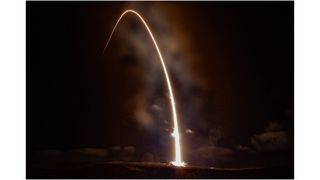
A SpaceX Falcon 9 rocket launches 21 Starlink satellites, including the first six direct-to-cell spacecraft, from California’s Vandenberg Space Force Base on Jan. 2, 2024.
(Image credit: SpaceX)
Well, that was fast.
SpaceX just broke in its new direct-to-cell Starlink satellites, using one of them to send text messages for the first time.
The milestone came on Jan. 8, just six days after the six Starlink spacecraft launched atop a Falcon 9 rocket from California’s Vandenberg Space Force Base, the company announced in an update on Wednesday (Jan. 10).
Those pioneering texts included the classic “New phone who dis?” as well as “Never had such signal” and “Much wow,” according to a SpaceX post on X on Wednesday. (SpaceX founder and CEO Elon Musk said the first message was “LFGMF2024,” but he was apparently joking.)
Related: SpaceX Starlink satellites to beam service straight to smartphones
Starlink is SpaceX’s satellite network in low Earth orbit that provides internet service to people around the world.
The megaconstellation currently consists of more than 5,250 functional spacecraft, but the six that went up on Jan. 2 were the first with direct-to-cell capabilities. (Those half-dozen launched along with 15 traditional Starlink satellites.)
Beaming connectivity service from satellites directly to smartphones — which SpaceX is doing via a partnership with T-Mobile — is a difficult proposition, as SpaceX noted in Wednesday’s update.
“For example, in terrestrial networks cell towers are stationary, but in a satellite network they move at tens of thousands of miles per hour relative to users on Earth,” SpaceX wrote. “This requires seamless handoffs between satellites and accommodations for factors like Doppler shift and timing delays that challenge phone-to-space communications. Cell phones are also incredibly difficult to connect to satellites hundreds of kilometers away, given a mobile phone’s low antenna gain and transmit power.”
The direct-to-cell Starlink satellites overcome these challenges thanks to “innovative new custom silicon, phased-array antennas and advanced software algorithms,” SpaceX added.

A prelaunch shot of the batch of SpaceX Starlink satellites — including the first six with direct-to-cell capability — that lifted off on Jan. 2, 2024. (Image credit: SpaceX)
Overcoming tough challenges can lead to great rewards, and that’s the case here, according to SpaceX President Gwynne Shotwell
“Satellite connectivity direct to cell phones will have a tremendous impact around the world, helping people communicate wherever and whenever they want or need to,” Shotwell said via X on Wednesday.
The Jan. 2 Starlink launch was SpaceX’s first of the year. But there will be many more: The company has said it aims to launch 144 orbital missions in 2024, which would break its record of 98, set last year.
Editor’s note: This story was updated at 6:10 p.m. EST on Jan. 11 to include some of the first texts sent via the direct-to-cell Starlink satellites.
Join our Space Forums to keep talking space on the latest missions, night sky and more! And if you have a news tip, correction or comment, let us know at: [email protected].
Breaking space news, the latest updates on rocket launches, skywatching events and more!
Michael Wall is a Senior Space Writer with Space.com and joined the team in 2010. He primarily covers exoplanets, spaceflight and military space, but has been known to dabble in the space art beat. His book about the search for alien life, “Out There,” was published on Nov. 13, 2018. Before becoming a science writer, Michael worked as a herpetologist and wildlife biologist. He has a Ph.D. in evolutionary biology from the University of Sydney, Australia, a bachelor’s degree from the University of Arizona, and a graduate certificate in science writing from the University of California, Santa Cruz. To find out what his latest project is, you can follow Michael on Twitter.
>>> Read full article>>>
Copyright for syndicated content belongs to the linked Source : Space.com – https://www.space.com/spacex-starlink-satellites-direct-to-cell-first-text-messages































